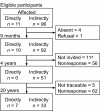A longitudinal follow-up of posttraumatic stress: from 9 months to 20 years after a major road traffic accident
- PMID: 21396118
- PMCID: PMC3063213
- DOI: 10.1186/1753-2000-5-8
A longitudinal follow-up of posttraumatic stress: from 9 months to 20 years after a major road traffic accident
Abstract
Background: Although road traffic accidents (RTA) are a major cause of injury and a cause of posttraumatic stress (PTS) in the aftermath, little is known about the long-term psychological effects of RTA.
Methods: This prospective longitudinal study assessed long-term PTS, grief, and general mental health after a bus carrying 23 sixth-grade schoolchildren crashed on a school outing and 12 children died. Directly affected (i.e., children in the crash) and indirectly affected children (i.e., all pupils in the sixth grade who were not in the crash) were surveyed at 9 months (N = 102), 4 years (N = 51), and 20 years (N = 40) after the event. Psychological distress was assessed by single items, including sadness, avoidance, intrusions, and guilt. After 20 years, PTS was assessed by the Impact of Event Scale-Revised.
Results: Stress reactions were prevalent 9 months after the event, with sadness (69%) and avoidance (59%) being highly represented in both directly and indirectly affected groups, whereas, nightmares (60%) and feelings of guilt (50%) were only frequent in those directly affected. The frequency of sadness and avoidance decreased after 4 years in the indirectly exposed (ps < .05). After 20 years, the directly affected had a higher prevalence of PTS (p = .003), but not decreased general mental health (p = .14), than those indirectly affected.
Conclusions: The limitations preclude assertive conclusions. Nonetheless, the findings corroborate previous studies reporting traumatic events are associated with long-term PTS, but not with decreased general mental health.
Figures
References
-
- Swedish National Board of Health and Welfare. Attendance at Accident and Emergency Departments due to injuries - Statistics from the Injury Database (IDB) Sweden, 2008 [Swedish]. Stockholm, Sweden. 2009.
-
- Kahana SY, Feeny NC, Youngstrom EA, Drotar D. Posttraumatic stress in youth experiencing illnesses and injuries: an exploratory meta-analysis. Traumatology. 2006;12:148–161. doi: 10.1177/1534765606294562. - DOI
-
- American Psychiatric Association. Diagnostic and statistical manual of mental disorders. 4. Washington: American Psychiatric Association; 2000.
LinkOut - more resources
Full Text Sources


